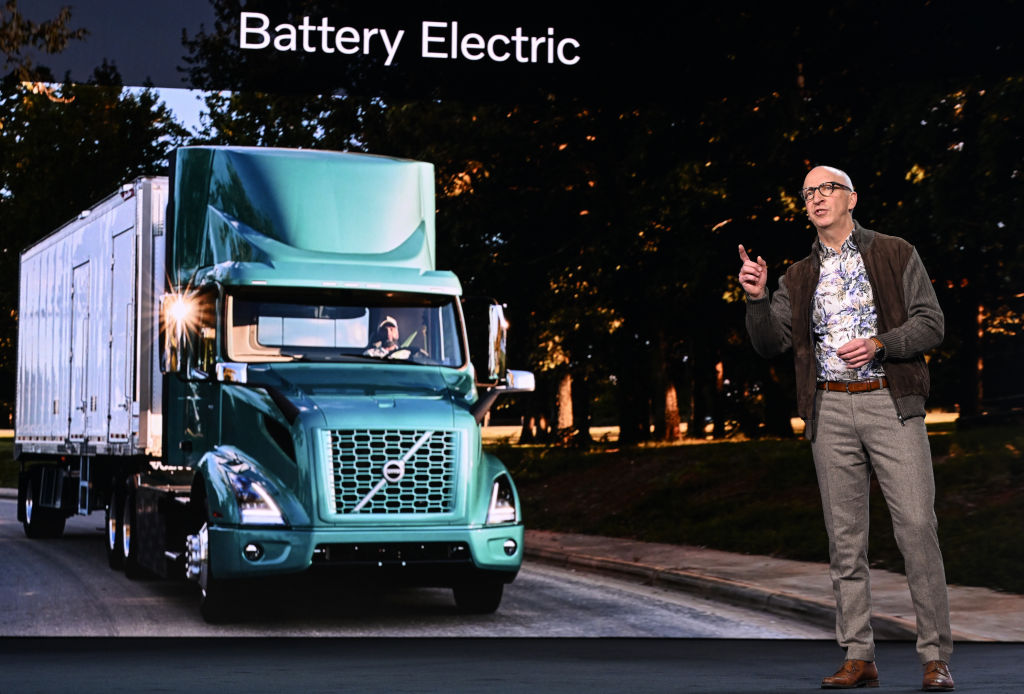The clean truck transition is here
Truck fleets across the country are enthusiastically embracing the emergence of electric medium- and heavy-duty trucks. So far, hundreds of companies have ordered 276,978 electric vehicles with 28,849 already on the road, including 24,693 medium and heavy-duty electric truck orders and deployments. This is the main finding of a new EDF analysis of public announcements and known deployments of leading fleets. See the full analysis here.
Volvo markets itself as a sustainable leader, but is stalling
- Despite having agreed to rules on clean trucks over three years ago, Volvo is now backtracking and passing on the pressure to dealers and fleet owners. Some are using “ratioing” schemes to force unwanted EV purchases on dealers, even though no such requirement exists in the rules.
- Truck manufacturers like Volvo are also hiding behind their membership in industry associations like The Transport Project to lobby lawmakers to weaken clean truck regulations.
- Rolling back these plans leaves fleets and businesses stranded, especially those who have already invested in electric. Volvo can’t lead on a clean future while undermining it.
Why the ACT means ACTION?
States like California and Oregon are driving the clean truck shift with flexible Advanced Clean Truck (ACT) rules that:
✅ Lowers costs
✅ Help fleets plan and save
✅ Grow EV options
✅ Support infrastructure
✅ Protect health and climate
The facts behind the ACT rule
The ACT’s goal is to help the medium- and heavy-duty vehicle (MHDV) sector increase consumer choice, reduce pollution, and drive economic growth. The ACT program requires manufacturers to sell an increasing percentage of zero-emission MHDVs over time. The standard does not affect used vehicles and does not stop the sale of fossil fuel vehicles, but rather sets supply targets for new electric vehicles.
-
- For fleets, the ACT rule contributes to cost control and market expansion.
- The ACT rule accelerates electric truck deployment and lowers costs by expanding model availability and promoting increased charging infrastructure.
- Most electric trucks already offer cost savings over the trucks’ lifetime through fuel savings and maintenance expenses.
- Wider adoption of the ACT rule helps build a bigger market, drives competition, and makes zero-emission trucks more affordable for everyone.
- The ACT rule supports long-term planning for all industry players.
- ACT is not a mandate for immediate electrification. It is phased and flexible, allowing businesses to adapt at a manageable pace. The policy gives businesses clarity and confidence to invest–knowing infrastructure and supply chains will continue to build over time.
- With incentives already in place, the ACT rule positions businesses to benefit, not bear unnecessary burdens.
- The ACT rule will ensure a steady, reliable increase in zero-emission truck availability—giving fleets more options, not fewer.
- Clean truck rules are realistic and achievable. Ignoring global trends towards electrification will cost truck manufacturers market share and long-term profitability.
- Claims about overnight transitions or forced electric truck purchases are false. Manufacturers have broad compliance flexibility and many are already ahead of their ACT targets. Businesses can adopt electric trucks where it makes sense first, and scale with the market.
- Globally, automakers leading in EVs are projected to see the highest future profits.
- Analysis of the EU market found that domestic manufacturers lagging in EV production risk losing up to 11% market share to foreign competitors. If US automakers prioritize short-term profits on gas-powered vehicles, they risk losing market share and profits in an increasingly global manufacturing landscape. Countries like China are rapidly scaling electric freight vehicles. U.S. fleets can’t afford to be left behind.
- For fleets, the ACT rule contributes to cost control and market expansion.



